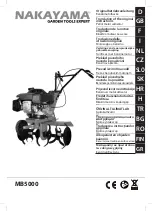
34
MAINTENANCE AND OPERATING MANUAL
Chapter 9 - Operation and maintenance
The data inside this manual are not binding and they can be modified by the manufacturer without notice.
All rights reserved.
TAEevo015÷351
9 . 4
E m p t y i n g t h e p r o c e s s w a t e r c i r c u i t
Use the cock installed on the unit lower side if the storage tank need to be emptied for maintenance purposes (in models fitted with a hydraulic
unit).
ATTENTION
The water circuit must be emptied when a unit that has no heating elements or anti-freeze liquid is to be left inactive for a certain period of
time in an environment where the temperature may fall low enough to freeze the water in the evaporator (with the risk of breaking the
evaporator).
9 . 5
M a i n t e n a n c e s c h e d u l e
ATTENTION
- This plan is based on an average working situation.
- In some installations it may be necessary to increase the frequency of maintenance.
OPERATION
1 d
ay
1 m
on
th
6 m
on
ths
1 ye
ar
Check for any alarm signals.
x
Check that the water outlet temperature is within the envisaged range.
x
Check that the water inlet temperature is in accordance with the value used for selecting the unit.
x
In units with hydraulic group, check that the pressure in the tank (with pump stopped, if present) is at least
0.5 bar with the circuit closed.
x
In units with hydraulic group, check that the difference between the discharge and the suction pressure of
the pump (measured on the manometer with the pump stopped) is within expected limits and, in particular,
that it is not lower than the value corresponding to the maximum flow capacity.
x
Clean the water filter.
We recommend to clean the filter after a week from the unit starting.
x
Check that the liquid indicator (if present) is full or with a small stream of bubbles when the compressor is
running.
x
Check that the unit current absorption is within the values on the data plate.
x
Carry out visual inspection of refrigerant circuit, looking out for any deterioration of the piping or any traces
of oil which might indicate a refrigerant leak.
x
Check the condition and security of piping connections.
x
Check the condition and security of electrical connections.
x
Using a spanner, check that the connections between the compressor inlet and outlet pipelines have not
slackened.
x
Check that the ambient air temperature is within the unit capacities.
Check that the environment is well ventilated.
x
Check that fan is automatically switched on
.
Thoroughly clean the fins of the condenser with soft brush and/or jet of clean compressed air.
Check that the grilles of the unit are free from dirt and any other obstructions.
x
Clean condenser fins with a mild detergent.
x
Summary of Contents for TAEevo015
Page 3: ......











































